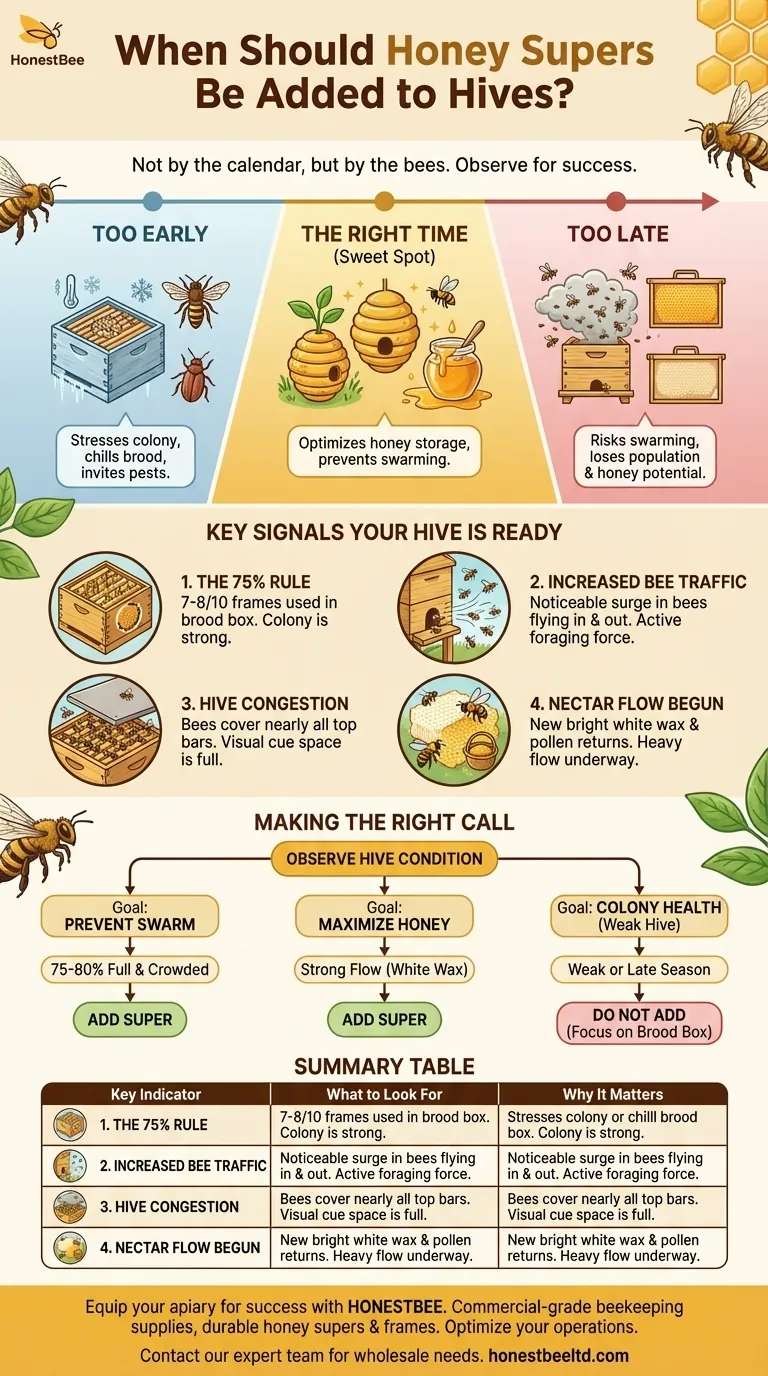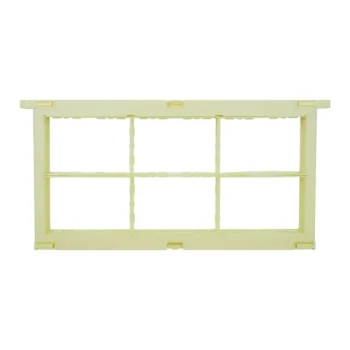The right time to add a honey super is not determined by the calendar, but by the bees themselves. While some beekeepers use general timeframes like mid-April as a guide, the true indicators are a strong colony population and the start of a major nectar flow. Paying attention to specific signals inside the hive is the only reliable way to know when your bees need more space.
Adding a honey super too early can stress the colony, while adding it too late risks losing your bees to a swarm. Success depends on observing clear signs of strength and nectar collection, not on following a fixed date on the calendar.

The Purpose of a Honey Super
What is a Honey Super?
A honey super is simply a box with frames placed on top of the main hive body. Its name comes from its "superior" or upper position in the hive stack.
These boxes are typically shallower and smaller than the main brood boxes. This design makes them lighter and easier to lift when they are completely full of heavy honey.
Why Correct Timing is Critical
The super provides dedicated space for bees to store surplus honey—the honey you intend to harvest. Giving them this space at the right moment is crucial for hive health and honey production.
Your goal is to give them room to expand right when they need it, channeling their energy into honey storage instead of swarm preparations.
Key Signals Your Hive is Ready
Instead of relying on a date, look for these definitive signs inside your hive. When you see a combination of these indicators, it is time to add a super.
The 75% Rule
The most common and reliable rule is to check the brood box. Once the bees have drawn out comb and are using 7 to 8 of the 10 frames for brood, pollen, or nectar, they are ready for more space.
This shows the colony is strong, growing, and will soon run out of room.
Increased Bee Traffic
Observe the hive entrance. A noticeable increase in the number of bees flying in and out is a strong sign that the colony is active and bringing in significant resources.
This high level of activity indicates a healthy population and a strong foraging force.
Signs of Hive Congestion
When you remove the inner cover, look at the top bars of the frames. If the bees have built up and are covering nearly all the top bars, the hive is becoming congested.
This is a clear visual cue that the bees perceive their current space as full and are running out of room to work.
The Nectar Flow Has Begun
Look for evidence of fresh nectar coming into the hive. You may see bees returning with full pollen baskets, and inside, you will see new, bright white wax being built on the tops of the frames.
This "whitening" of the comb is a classic sign that bees are processing a heavy nectar flow and need a place to store it.
Understanding the Trade-offs
Timing is a balancing act. Both adding a super too early and adding one too late come with significant consequences.
The Danger of Adding a Super Too Early
If you add a super to a weak colony or before the weather is consistently warm, you create a large empty space that the bees must patrol and keep warm.
This can chill the brood nest, slowing the queen's laying and the colony's development. It can also invite pests like wax moths or small hive beetles to move into the undefended space.
The Consequence of Adding a Super Too Late
Waiting too long is the most common mistake. When a strong colony runs out of space, its natural instinct is to swarm.
The bees will assume their hive is full and begin preparations to split, with the queen and half the workforce leaving to find a new home. This dramatically reduces your hive's population and honey-producing potential for the season.
Making the Right Call for Your Hive
Use your hive's condition, not the calendar, as your guide. Your decision should be based on direct observation.
- If your primary focus is preventing a swarm: Add a super as soon as you see the brood box is 75-80% full and bees are beginning to crowd the top bars.
- If your primary focus is maximizing honey: Ensure a strong nectar flow has begun (look for white wax) before adding the super, so bees start filling it immediately.
- If your primary focus is colony health: Do not add a super to a weak hive, even if it's late in the season; focus on helping the colony build its strength in the brood box first.
By learning to read the signs your colony provides, you can effectively manage their space and ensure a productive season.
Summary Table:
| Key Indicator | What to Look For | Why It Matters |
|---|---|---|
| 75% Rule | 7-8 out of 10 frames in use in the brood box. | Signals the colony is strong and needs more space to expand. |
| Increased Bee Traffic | A noticeable surge in bees flying in and out of the hive entrance. | Indicates a healthy, active foraging force bringing in resources. |
| Hive Congestion | Bees covering nearly all top bars of the frames when the inner cover is removed. | A clear visual cue that the hive is perceived as full. |
| Nectar Flow Begins | Bees returning with full pollen baskets; new, bright white wax on frames. | Confirms a heavy nectar flow is underway, requiring storage space. |
Equip your apiary for success with HONESTBEE.
Managing hive space is critical for colony health and honey yield. As a trusted supplier of commercial-grade beekeeping supplies and equipment, HONESTBEE provides the durable, reliable tools—including high-quality honey supers and frames—that commercial apiaries and distributors need to optimize their operations.
Let us help you build a more productive season. Contact our expert team today to discuss your wholesale needs and discover how our products support strong, thriving hives.
Visual Guide

Related Products
- Langstroth Honey Bee Box Hive Boxes for Different Depths
- Professional 500g Sectional Comb Honey Frame System for Beekeeping
- Economy Small Scale Honey Dryer Dehumidifier Thickening Machine
- High-Efficiency Diamond Maze Bee Escape for Clearing Supers
- Portable Bee Mating Hive Boxes Mini Mating Nucs 8 Frames for Queen Rearing
People Also Ask
- How deep is a medium bee box? Unlock the Key to a Versatile and Manageable Hive
- What factors should beekeepers consider when choosing between wooden and polystyrene hives? Maximize Bee Health and Honey Production
- What is the best time to inspect a hive? Optimize for Bee and Beekeeper Safety
- How does a hive box work? A Guide to the Langstroth Hive System for Beekeepers
- Why do you need two bee hives? Boost Your Apiary's Success with Smart Risk Management



















